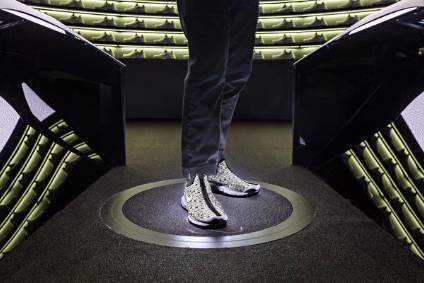
Nike, Adidas and Under Armour are all on parallel missions to supercharge their supply chains through the introduction of so-called “speed” factories, but it’s becoming clear that there’s no quick-fix solution and the process requires a steep learning curve.
Whether it’s Adidas’s Speedfactory concept, Under Armour’s UA Lighthouse or Nike’s partnership with Flex, numerous initiatives are underway to create faster and more agile supply chains by incorporating sophisticated digital tools and automation into the production process.
And there’s no doubt they have multi-pronged potential, be it delivering goods faster to market and in the right quantities, producing products at a lower cost, or creating production techniques that lead to better, more customised products.
Yet the scaling of these concepts still appears to be some way off.
Back in 2015, Nike teamed up with Flex – which provides design, engineering, manufacturing, supply chain and logistics services across various industries – in a bid to revolutionise how it makes footwear.
Indeed, analysts at the sporting goods giant’s investor day in Oregon last October heard how the partnership had moved into a new nearshore purpose-built footwear factory due to deliver over 3 million pairs to North America in fiscal 2018.

US Tariffs are shifting - will you react or anticipate?
Don’t let policy changes catch you off guard. Stay proactive with real-time data and expert analysis.
By GlobalDataBy 2023, together with Flex, “we plan to produce tens of millions of pairs nearshore with more than 25% of those volumes delivered through Nike Direct on a short lead time responsive model,” according to chief operating officer Eric Sprunk.
“This strategic relationship allows us to take our standard time from manufacturing to market from about 60 days to 10 days or less. And Flex isn’t just another contract manufacturer. We’re inventing new manufacturing capabilities at scale together.”
Among the highlights of the initiative, “we’re already commercialising Flyknit, end to end, 12 weeks faster than through our traditional manufacturing process,” he said. And for Nike iD customers who choose to design their own customised Free Run Flyknit shoes, they are knitted to order, with delivery promised in under 10 days.
Reset expectations
Shedding some insight into the process, Flex management told analysts on the company’s recent first quarter earnings call that as far as its Nike business is concerned, “we’ve reset expectations that it’s going to be a little bit slower and take a little bit longer.”
Nike sits within Flex’s Consumer Technologies Group (CTG), and the unit’s underperformance was partly blamed on “sustaining losses from our strategic partnership with Nike.”
That said, the company is optimistic for improved profitability of the Nike operations in the second half of the year.
“We expect to significantly increase revenue over the remainder of the year,” says CEO Mike McNamara. “The manufacturing system is rapidly improving productivity, our know-how is accelerating, and our losses are improving. We expect margins to move to profitability in the second half of the year.”
While Flex works with Nike to ensure some shoes are entirely designed and built for the automation, these products account for “a small total percentage” of the process. Instead, much of the automation that Flex is putting in place covers different steps, such as glueing the upper and midsole together.
Flex’s lack of experience in manufacturing footwear was one of its key credentials “to help us think differently as an industry” and rethink some processes, according to Sprunk.
Laser cutting is a case in point. Using laser cutters allows for much greater flexibility, but leaves burnt edges on soft fabrics.
So engineers and chemists at Flex “invented a process whereby any material, soft or hard, can be neatly laser-cut into whatever pattern is needed, when it’s needed, right on the factory floor,” the company explains in its Intelligence Magazine.
The machine can go from cutting size 13 pieces to size 7 pieces without interrupting the factory-line flow, bringing Nike closer to its goal of faster turnarounds for custom orders.
Flex has also tackled the major challenge of working with soft materials, testing how different materials, threads, and even colours respond to automation, and nailing down each of its “recipes” as it went along.
The team also had to quantify precisely such things as the amount of glue to use between the upper and midsole to achieve optimal bond strength – eventually arriving at the perfect thickness for its cementing machine.
To help restitch Nike’s supply chain, Flex is also experimenting with the company’s manufacturing infrastructure to introduce other innovations while speeding up the process. Without disclosing detail, these tweaks could involve sensors embedded in equipment to feed back data that could be used to optimise the whole operation.
See also:



